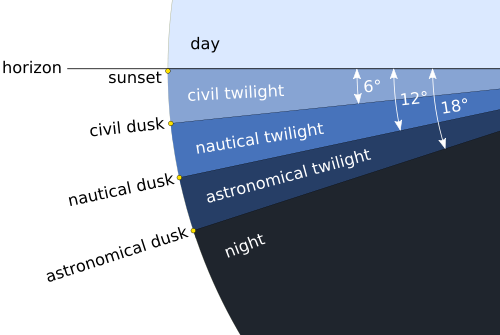
Tonight – June 24, 2019 – if you’re located around 40 degrees north latitude, it’s your latest evening twilight for the year. The longest evening twilights always happen around the summer solstice. Although the Northern Hemisphere’s summer solstice, and longest day, happened a few days ago on June 21, the latest twilight at 40 degrees north latitude always occurs several days afterwards, on or near June 24.
The parallel 40 degrees north passes through Philadelphia, Pennsylvania, and the northern suburbs of Denver, Colorado. Worldwide the 40th parallel runs through Beijing, China; Turkey; Japan and Spain.
Want to know for your latitude? Click here and check the “astronomical twilight” box.
The year’s latest sunsets don’t come exactly on the solstice either. For 40 degrees north latitude, the latest sunset happens about a week after the summer solstice, on or near June 27.
Let us introduce you to the three different kinds of twilight:
Civil twilight starts at sundown and ends when the sun is 6 degrees below the horizon.
Nautical twilight occurs when the sun is 6 to 12 degrees below the horizon.
Astronomical twilight happens when the sun is 12 to 18 degrees below the horizon.
North of 50 degrees north latitude, there’s no true night in the month of June. In June, that far north, the sun never gets far enough below the horizon for true night to occur.
It’s the land of the midnight twilight from 50 degrees north latitude to the Arctic Circle (66.5 degrees north latitude).
It’s the land of the midnight sun from the Arctic Circle to the North Pole (90 degrees north latitude).
At the temperate zones and the tropics, the longest period of twilight after sunset or before sunrise happens around the summer solstice, and the shortest period around the equinoxes. At 40 degrees latitude, astronomical twilight ends about 2 hours after sunset on the summer solstice; and on the equinoxes, astronomical twilight ends about 1 1/2 hours after sunset. Believe it or not, the duration of astronomical twilight reaches a secondary peak around the winter solstice, lasting about 1 2/3 hours after the sun goes down at 40 degrees latitude.
Read more: What exactly is twilight?
Bottom line: Although the latest sunset won’t happen at 40 degrees north latitude for another few days, the latest twilight happens on June 24.
from EarthSky http://bit.ly/2WXkdNc

Tonight – June 24, 2019 – if you’re located around 40 degrees north latitude, it’s your latest evening twilight for the year. The longest evening twilights always happen around the summer solstice. Although the Northern Hemisphere’s summer solstice, and longest day, happened a few days ago on June 21, the latest twilight at 40 degrees north latitude always occurs several days afterwards, on or near June 24.
The parallel 40 degrees north passes through Philadelphia, Pennsylvania, and the northern suburbs of Denver, Colorado. Worldwide the 40th parallel runs through Beijing, China; Turkey; Japan and Spain.
Want to know for your latitude? Click here and check the “astronomical twilight” box.
The year’s latest sunsets don’t come exactly on the solstice either. For 40 degrees north latitude, the latest sunset happens about a week after the summer solstice, on or near June 27.
Let us introduce you to the three different kinds of twilight:
Civil twilight starts at sundown and ends when the sun is 6 degrees below the horizon.
Nautical twilight occurs when the sun is 6 to 12 degrees below the horizon.
Astronomical twilight happens when the sun is 12 to 18 degrees below the horizon.
North of 50 degrees north latitude, there’s no true night in the month of June. In June, that far north, the sun never gets far enough below the horizon for true night to occur.
It’s the land of the midnight twilight from 50 degrees north latitude to the Arctic Circle (66.5 degrees north latitude).
It’s the land of the midnight sun from the Arctic Circle to the North Pole (90 degrees north latitude).
At the temperate zones and the tropics, the longest period of twilight after sunset or before sunrise happens around the summer solstice, and the shortest period around the equinoxes. At 40 degrees latitude, astronomical twilight ends about 2 hours after sunset on the summer solstice; and on the equinoxes, astronomical twilight ends about 1 1/2 hours after sunset. Believe it or not, the duration of astronomical twilight reaches a secondary peak around the winter solstice, lasting about 1 2/3 hours after the sun goes down at 40 degrees latitude.
Read more: What exactly is twilight?
Bottom line: Although the latest sunset won’t happen at 40 degrees north latitude for another few days, the latest twilight happens on June 24.
from EarthSky http://bit.ly/2WXkdNc


Aucun commentaire:
Enregistrer un commentaire